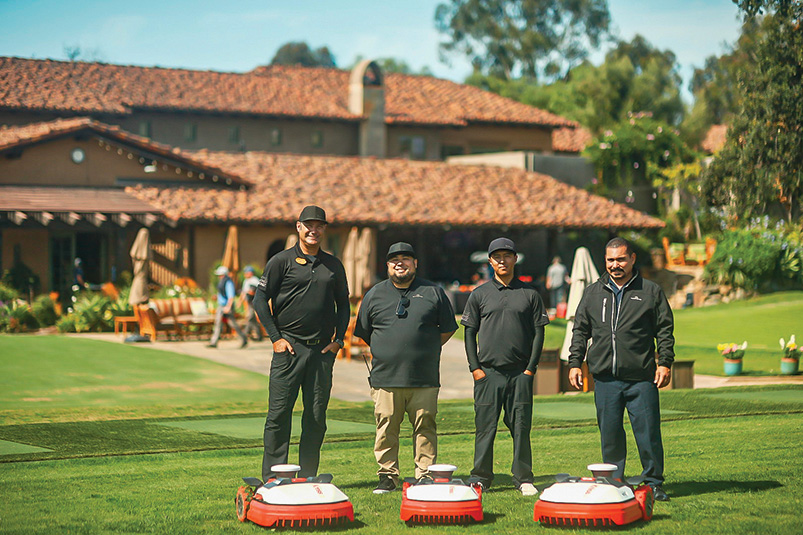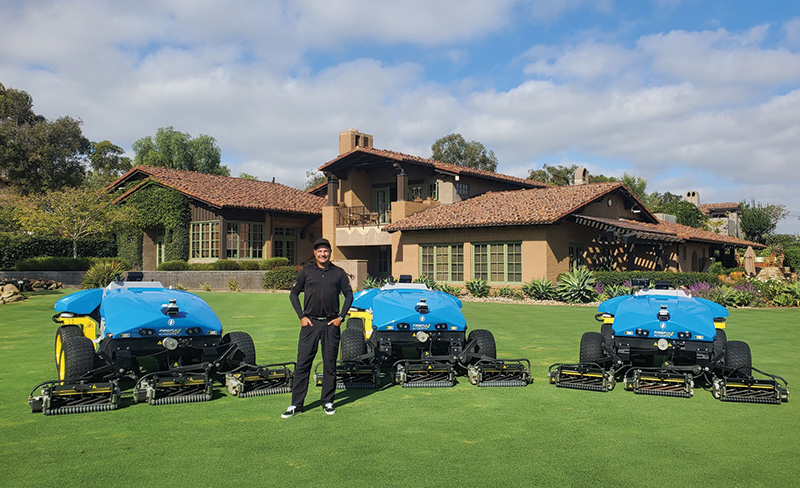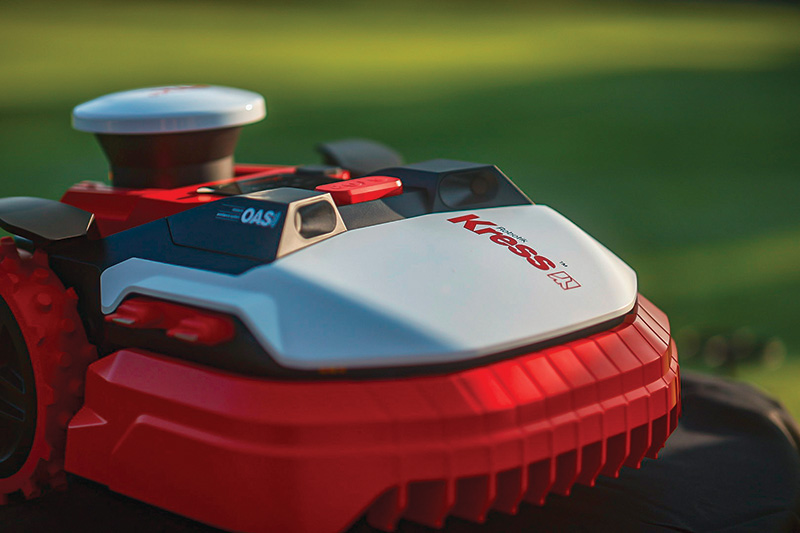
Standing with a few of their Kress autonomous mowers are (from left) Jeff Miller, director of agronomy at The Santaluz Club; Tommy Caranci, superintendent; Abel Sixtos, assistant superintendent; and Sal Soto, equipment manager. Photos courtesy of Jeff Miller
Jeff Miller is going on 10 years of using a variety of autonomous mowers on his course, The Santaluz Club, just north of San Diego. So, by now, the GCSAA Class A director of agronomy is quite used to being an informal consultant on the technology.
“I get a lot of phone calls. Many, many superintendents, GMs, even vendors — they’ve actually traveled down here. I’ve had a guy from Japan walk in my door asking about the Fireflys,” Miller says, referring to the brand of his autonomous fairway mowers. “Phone calls from the UK … all over, just people interested in which piece of equipment is better”.
“I think people are trying to figure out how well does it work, does it really work, how hard is it to install, do I need someone who is more technically advanced to operate and keep them going — those are the questions and concerns I hear.”
Miller — a 25-year association member who has been at Santaluz since 2001 — is happy to play the part of consultant. He plans to attend the 2025 GCSAA Conference and Trade Show in his San Diego back yard and expects to see an uptick in inquiries.
“When we’re here in San Diego, I’m sure I’ll have a lot of people ask to come out to the golf course and see our property. I’ll do some tours and share what we’ve learned,” Miller said.
The move to autonomous mowing
Miller took the plunge into autonomous mowers in 2015 with RG3 greens mowers by Cub Cadet.
“We ran six of those for five years, from 2015 to 2020, so we had a bunch of experience with the robotic technology,” Miller said. “We were really impressed with how much productivity we got out of those.”
However, that experience was short lived — in 2020, Cub Cadet stopped supporting the mowers. “When they stopped supporting units, we stopped using them. They needed software support and tech support,” Miller says.
During the growing season (March through October), the 22 Kress units he now uses mow three times per week, mowing 90% of Miller’s 60 acres of rough each time, Miller says. “There’s one day that the robot rests,” he says, “so we clean them, get the grass clippings from underneath and change blades once a month during the growing season.”
There are limitations to the autonomous mowers. They can’t mow the course’s entire rough and leave a perimeter of unmowed grass at the edge of the rough and around bunkers. “So, we still have a traditional manual labor mower — a trim mower, a 48-inch wide rotary mower, that we use to do a loop around the perimeters and around each of the bunkers. It takes about 12 hours total over two days to mow those 4 acres of rough,” Miller says.
“I was putting in around 2,200 hours a year with our traditional mowers. Now we just need about 300 hours to do the trim mowing,” Miller said. He said that saves about $6,000 in fuel per year and about $50,000 per year in labor.
“With these mowers, the aesthetics are better. The roughs are smoother, it’s a cleaner cut, and the overall health is better. And I think the membership is happier because the roughs are consistent Monday to Sunday, no matter what day you come out,” Miller says.

Miller with his three Firefly autonomous fairway mowers.
Firefly mowers for the fairways
This June, The Santaluz Club also implemented large autonomous mowers for its 30 acres of fairways. It purchased three Firefly AMP mowers.
Unlike the smaller Kress mowers, the Firefly is a large five-gang, 100-inch mower and is not fully autonomous, says Miller.
“The Fireflys live and charge at the golf course maintenance facility,” Miller says. “Once they’re charged, three employees drive each unit out to their assigned holes, where the employee initiates the Firefly mowing that hole. The employee sets what direction and how fast to mow. From that point, the Firefly is in autonomous mode.”
Miller says while the Firefly is mowing, the employee rakes out the greenside bunkers by hand and spot-checks each fairway bunker.
“When he’s done, if the Firefly is still mowing, he can pull weeds or fix ball marks,” Miller says. “Then the employee will drive the Firefly to the next assigned hole. We mow the entire 30 acres of fairways from 5 a.m. to about 9:30 a.m.”
“The Fireflys are virtually silent, so I can mow in the middle of the night if I want to,” Miller says. “The flexibility it gives me is pretty incredible, to mow any time and not worry about homeowners calling. They’re very aware of when large diesel mowers are going out early in the morning. So it’s been nice for the community to go to electric mowers. They would be worth purchasing even if they weren’t autonomous — they’re that good.”

One of the Firefly autonomous mowers in action at The Santaluz Club.
Demos at Conference and Trade Show
Kress will be one of seven autonomous mower companies on hand at the 2025 GCSAA Conference and Trade Show, which will run Feb. 3-6. Kress plans to demonstrate its products just outside the convention hall on actual grass strips on the San Diego Convention Center property.
It’s the first conference at which Kress will have done live demos, but just one of many dozens of demos they’ve done, including one last month at The Santaluz Club attended by 30 superintendents. The demos give superintendents a chance to see just how accessible the technology is for implementation on a golf course, said Todd Zimmerman, Kress vice president of product development.
“What they’ll see is a Kress robot maintaining a yard with no boundary wire and no satellite with pattern mowing that can be adjusted and scheduled via an app,” Zimmerman said. “We will be showing them how to do the install. We’ll show them what our app is capable of doing from a scheduling standpoint and being able to adjust cutting heights for different areas, and they’ll be able to see the mower actually executing what it is we’re showing them on the app.”
The live demo at CTS will give his team a chance to address common questions and concerns superintendents have in making the transition to autonomous mowers.
“A lot of the questions we hear from superintendents are around whether robotic mowers are truly capable of mowing the acreage that we need it to mow in the time that it has to mow,” Zimmerman said. “As we’re implemented on more and more golf courses, we’re able to share their details and say emphatically, ‘Yes, it’s capable of doing it.’”
He said other common questions that come up are around the charging stations that every robot needs and the electrical requirements they’ll have on their course.
“If they have irrigation controls out already, we can tie into that,” he said. “It’s all a matter of us working with the course to understand what their course layout looks like and what robots would be needed to cover the course.”

One of the Kress mower in action at The Santaluz Club.
Zimmerman said most superintendents already understand the benefits robotics offer, and many have looked at robotics in the past, but didn’t find the right technology to implement on their course.
“A lot of the hesitation in the past was that the only offerings out there were using boundary wires, and that was really limiting given the amount of boundary wire needed,” he says. “Now the technology has advanced, and the boundary wires are no longer needed, using the virtual boundary. I think that’s opening eyes to golf courses implementing robotics sooner rather than later.”
In addition to the outdoor area dedicated to live demos, the 2025 CTS will feature a range of sustainability technologies with applications on golf courses, such as drones and moisture and irrigation technology.
Ed Several, GCSAA chief marketing officer, said the conference would center around technology that supports the sustainability of golf courses into the future. “This will be the most interactive experience in golf course maintenance technology — you won’t find it anywhere else. You can’t Google it, you can’t read about it, but by attending the GCSAA Conference and Trade Show you have the opportunity to be hands-on with this technology,” he said. “It’s a totally interactive experience that includes drones, demonstrations on autonomous equipment, being able to talk with your fellow golf course superintendents and equipment managers who already have experience with this sort of technology.”
Phil Cauthon (pcauthon@gcsaa.org) is GCM’s managing editor.